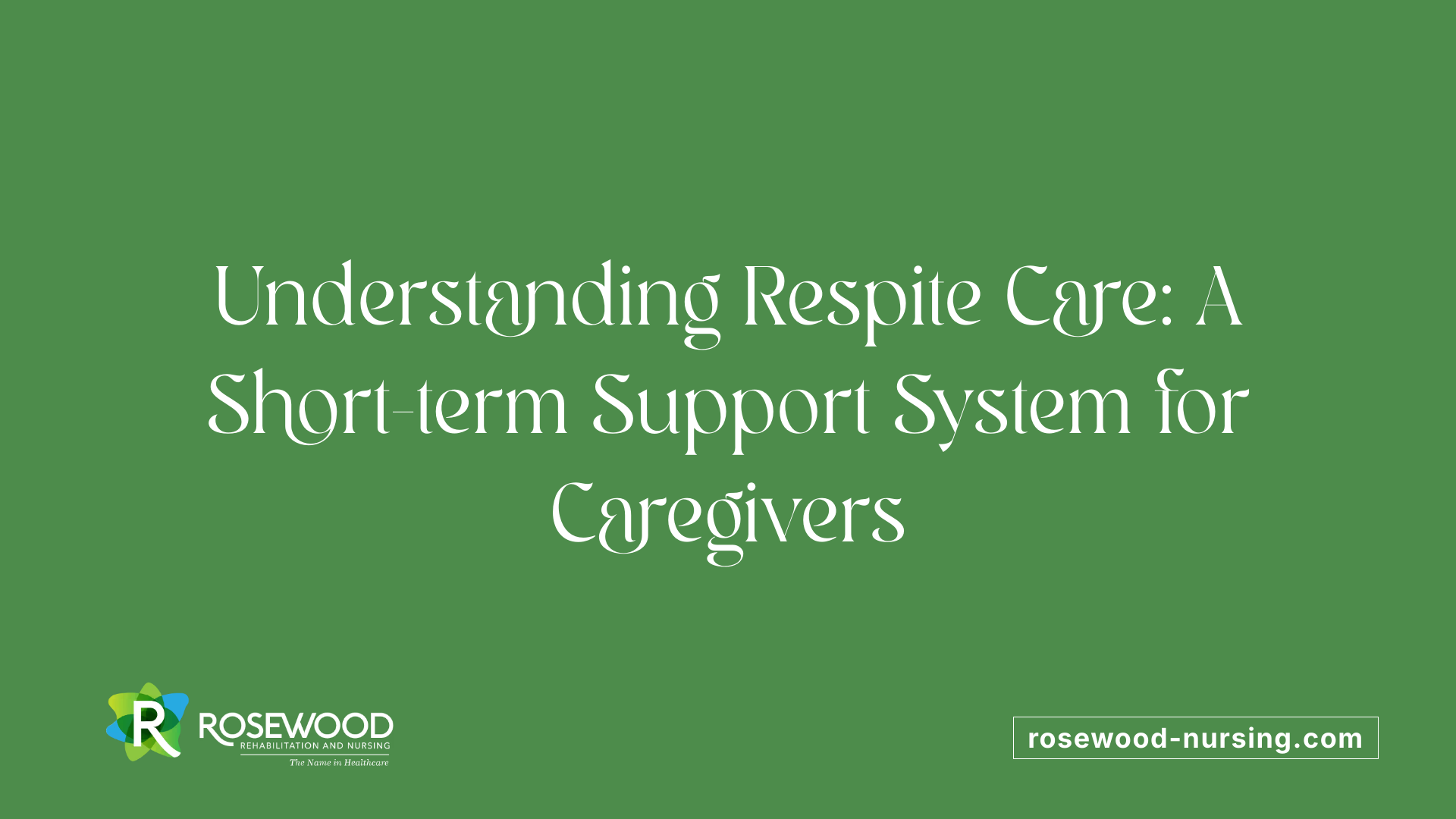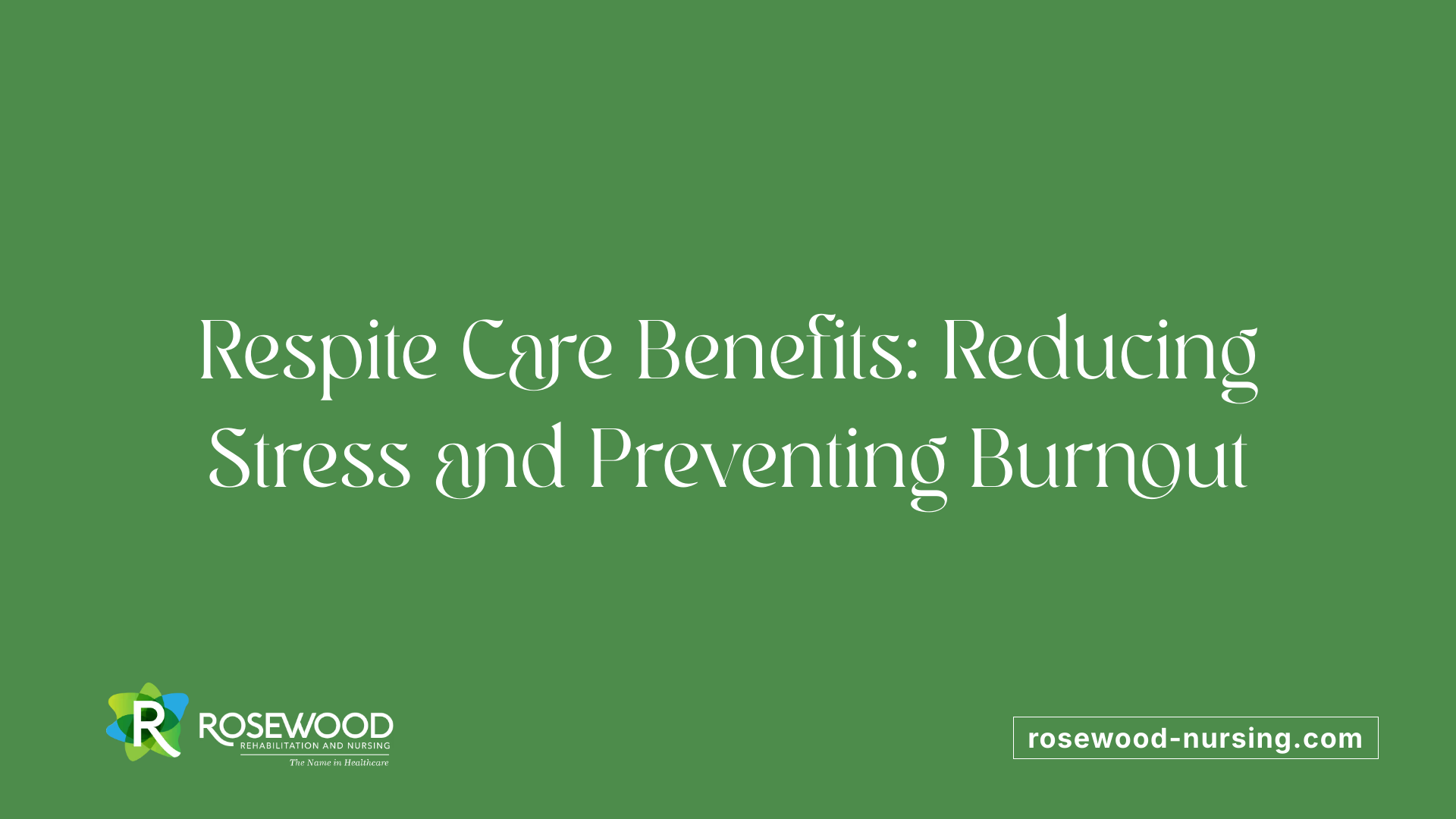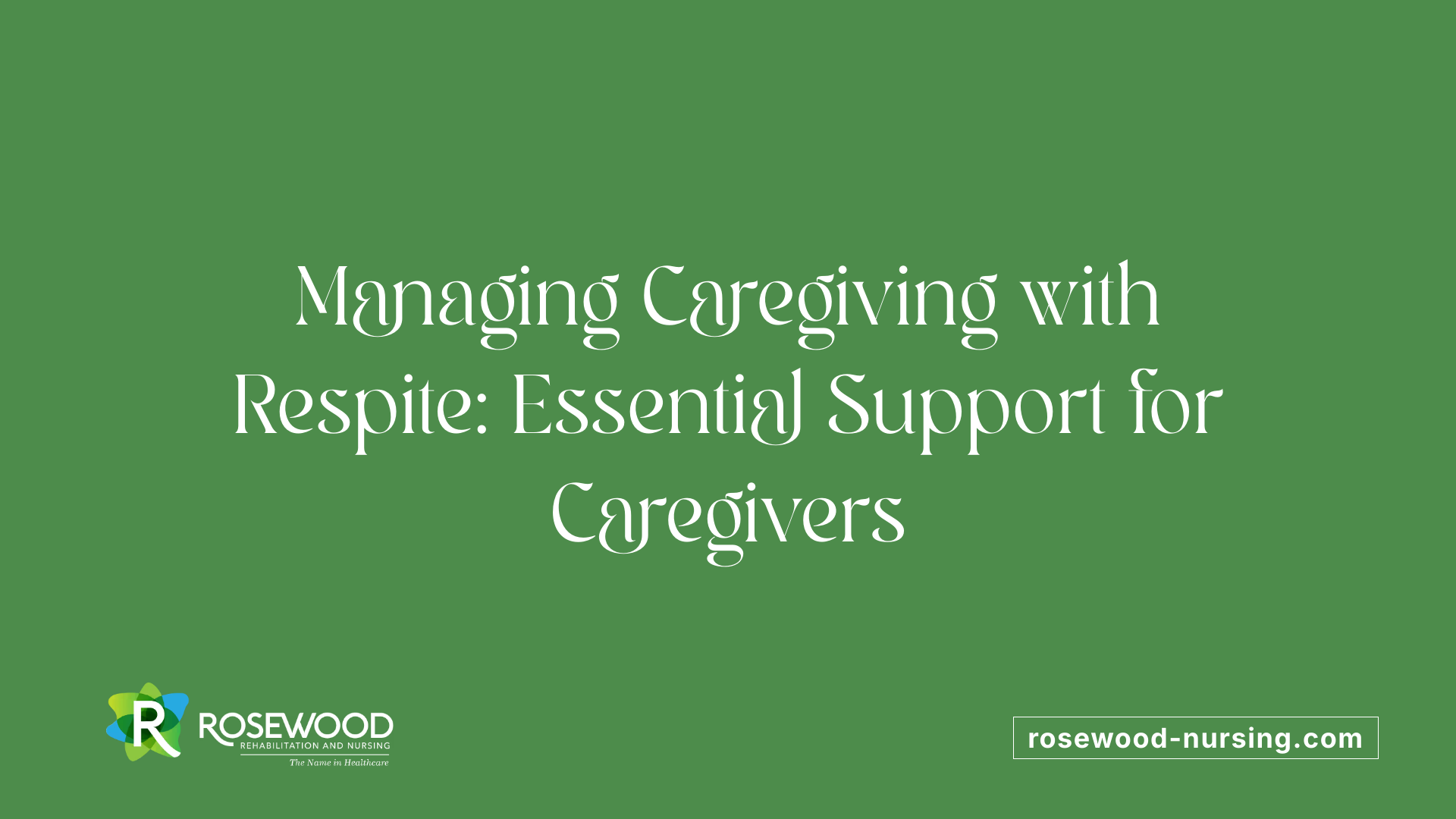What Is Respite Care, and How Can It Help Families?
June 17, 2025
Supporting Caregivers with Respite Services

Understanding the Importance of Respite Care
Respite care is a critical support system for families and caregivers, providing temporary relief from the demanding responsibilities of caring for loved ones with health needs or disabilities. It not only assists caregivers in managing stress and preventing burnout but also ensures that care recipients continue to receive quality support in various environments. This article explores the many facets of respite care, including its types, benefits, eligibility, access, costs, and the vital role it plays in sustaining family caregiving.
What Is Respite Care and Its Purpose

What is respite care?
Respite care is a service that offers temporary support to family caregivers by taking over their responsibilities for a short period. It can involve in-home assistance, adult day care programs, or care in residential facilities.
Short-term relief offered
This service provides caregivers with much-needed breaks, whether they need a few hours, a day, or several weeks. Respite care helps prevent burnout by allowing caregivers to rest, manage personal appointments, or take a holiday.
Duration and settings of respite care
Respite care duration varies widely, ranging from just a few hours to several weeks depending on the caregiver’s needs. It can take place in various environments, including at home, in specialized adult day care centers, or in residential care settings such as assisted living or nursing homes.
What is the purpose of respite care?
Respite care provides short-term relief for primary caregivers, giving them time to rest, travel, or spend time with other family and friends. The care may last anywhere from a few hours to several weeks at a time.
Respite care not only supports the wellbeing of caregivers but also ensures that the individual receiving care continues to get appropriate support in a safe and comfortable environment. This service is especially valuable for caregivers supporting older adults, individuals with disabilities, or those with chronic health conditions, helping maintain their health and safety while fostering better caregiver health and family relationships.
How Respite Care Benefits Families and Caregivers
 Respite care provides essential support to families and caregivers by offering a much-needed break from their demanding responsibilities. One of the primary benefits is stress reduction. Caregiving, especially for individuals with chronic health conditions, disabilities, or severe illnesses, can be emotionally and physically exhausting. Respite care helps alleviate this burden, giving caregivers time to rest, recharge, and focus on their own health.
Respite care provides essential support to families and caregivers by offering a much-needed break from their demanding responsibilities. One of the primary benefits is stress reduction. Caregiving, especially for individuals with chronic health conditions, disabilities, or severe illnesses, can be emotionally and physically exhausting. Respite care helps alleviate this burden, giving caregivers time to rest, recharge, and focus on their own health.
Prevention of burnout is another vital advantage. Continuous caregiving without adequate breaks can lead to burnout, characterized by physical fatigue, emotional exhaustion, and decreased patience. Regular access to respite services helps caregivers sustain their energy levels and emotional resilience, reducing the likelihood of burnout and their subsequent health issues.
Supports emotional and physical health by allowing caregivers to attend medical appointments, participate in hobbies, or simply relax. Such activities are crucial for maintaining mental well-being and physical vitality. Respite care arrangements can vary from a few hours to several weeks and may occur at home, at adult day centers, or in residential care facilities, providing flexibility tailored to individual needs.
Maintaining quality of care is also a significant benefit. When caregivers are rested and less stressed, they tend to provide better, safer, and more attentive care to their loved ones. Respite services can include assistance with household tasks, personal care, medication management, and transportation, ensuring that the care recipient continues to receive support in a comfortable environment.
Furthermore, respite care fosters stronger family relationships by reducing social isolation. It enables family members to reconnect with friends and engage in social activities, which can often be neglected due to caregiving demands. Overall, respite care supports not only the caregiver’s well-being but also the quality of life for the care recipient, ensuring that caregiving remains sustainable over the long term.
In summary, by providing temporary relief, respite care helps families manage stress, prevent burnout, promote health, and ensure ongoing, quality support for loved ones.
Types and Models of Respite Care Services
What are the types and models of respite care services?
Respite care offers a wide range of options designed to provide temporary relief for caregivers while ensuring that the care recipient continues to receive appropriate and consistent support. These services can be categorized into various types and models based on location, delivery method, level of medical support, and whether they are formal or informal.
One of the most common forms is in-home respite care. This involves a caregiver or professional visiting the person's home to provide assistance with everyday activities such as bathing, dressing, medication management, or companionship. In-home care can be provided by family members, friends, volunteers, or paid caregivers and is often supported by home health agencies or community organizations.
Adult day centers are community-based programs where individuals spend part of the day engaged in social, recreational, and some health-related activities. These centers typically operate during daytime hours and offer a safe environment for seniors, people with disabilities, or those recovering from illness. Transportation, meals, and personal care may be included.
Residential or institutional care includes facilities such as nursing homes, assisted living communities, and specialized respite centers. These facilities provide short-term overnight or extended stays, often equipped with medical staff to handle complex health needs. Some programs, like VA Community Living Centers, offer up to 30 days of respite care annually, scheduled in advance.
Informal respite is provided by family, friends, or community volunteers who step in temporarily without formal agency involvement. This can be as simple as a friend visiting to supervise or support the care recipient while the primary caregiver takes a break. Volunteer organizations often coordinate these efforts, providing companionship and assistance gratis.
Specialized models of respite include medical respite care for individuals experiencing homelessness, which offers short-term recovery in a safe, healthcare-equipped environment. These models follow varying frameworks such as Coordinated, Clinical, and Integrated Clinical Care, designed to address acute medical needs and help prevent hospitalization relapse.
Funding for these services comes from multiple sources. Medicaid often covers in-home and community-based respite services, especially under waivers for people with specific health conditions. Private insurance, long-term care policies, and federal programs like the VA also provide support, making these services accessible to a broad range of individuals.
Overall, the diverse types and models of respite care aim to meet varying needs, from brief social visits at home to overnight stays in care facilities, ensuring caregivers have flexibility and peace of mind while their loved ones are well cared for.
Who Qualifies for Respite Care and How to Qualify?

Who is eligible for respite care, and how can one qualify?
Respite care eligibility is tailored to individual circumstances, focusing on age, health, and the level of care needed. Senior adults seeking respite services generally need to be at least 62 years old, with their health being stable enough to benefit from short-term relief. They must also demonstrate a need for assistance with daily activities, which is typically confirmed through assessments that evaluate their health status, personal needs, and care preferences.
For persons with disabilities or chronic health conditions, including developmental and intellectual disabilities, eligibility often involves a detailed care requirement assessment. These assessments determine the intensity and type of services required, which could include in-home support or short-term stays at specialized facilities.
Family and informal caregivers can also access respite care if they meet certain criteria. Caregivers aged 18 or older are typically eligible to serve as respite providers, given they complete mandated training, background checks, or meet specific skill requirements. They may also need to sign agreements outlining responsibilities and expectations.
The qualification process usually involves a comprehensive evaluation of care needs, conducted by healthcare professionals or social service agencies. This process assesses medical, behavioral, and personal needs to develop a customized care plan. Family members or caregivers are often involved in planning to match the respite services to the individual’s unique needs. Facility tours, interviews, and assessments may be part of the evaluation to ensure the chosen care setting is appropriate.
Funding and program-specific criteria, such as those set by Medicare, Medicaid, or Veterans Affairs, may also influence eligibility. For example, Medicare covers up to five days of respite care in certain settings for hospice patients, provided specific conditions are met. Long-term care insurance policies might also have different eligibility criteria, often requiring policyholders to meet specified health or functional status thresholds.
Overall, qualifying for respite care involves a careful assessment of the individual's medical condition, care needs, and the caregiver’s situation, leading to tailored support arrangements that ensure safety, quality of care, and caregiver relief.
Finding, Accessing, and Evaluating Respite Care

How can families find, access, and evaluate respite care services?
Families seeking respite care can locate services through various resources such as the National Respite Locator, state Department on Aging, local community organizations, and advocacy groups like the ARCH National Respite Network or United Cerebral Palsy. These sources provide comprehensive listings of available programs and providers in specific regions.
Once identified, families should evaluate potential providers carefully. This involves screening credentials, verifying qualifications, and checking backgrounds to ensure safety and professionalism. Visiting the care facilities in person offers insights into the environment, staff interactions, and emergency response procedures.
It is crucial to match the respite option to the specific needs of the care recipient and caregiver. For example, some may prefer in-home services like companion or homemaker care, while others might opt for adult day care centers or residential respite facilities.
Recommendations from healthcare professionals, social workers, or support groups can assist in selecting reputable providers. Open communication about expectations and needs fosters trust and ensures quality care.
Planning ahead is vital—review costs, funding sources such as Medicaid, VA benefits, or long-term care insurance, and prepare emergency respite options. Developing backup plans for unexpected situations ensures continuous support, while regular assessments of care quality maintain trust and safety.
In summary, utilizing available resources, thoroughly screening providers, and planning strategically allows families to access dependable respite services that uphold the well-being of both caregivers and care recipients.
Costs, Payment Options, and Resources for Respite Care
Understanding the costs and available resources for respite care is essential for caregivers seeking relief from their demanding responsibilities.
Cost variations depend on the type of care and location. In-home care services, such as companionship or homemaker assistance, typically range from $20 to $35 per hour. Adult day care programs usually cost between $78 and $103 per day, providing social engagement and supervision during daytime hours. Residential options, like assisted living facilities or short-term nursing home stays, often cost around $200 per day, with temporary stays being about 10-20% more than standard rates. These expenses can add up quickly, so planning and budgeting are crucial.
When it comes to payment options, private pay remains the most common method. However, some families leverage long-term care insurance policies, which might cover part of the respite expenses. Federal programs like Medicaid can help reduce costs through waivers or specific plans in certain states, although coverage varies widely. Veterans benefits and community-based programs also offer financial assistance, including respite vouchers for eligible individuals. It’s important to note that most private health insurance plans do not fully cover respite care.
Fortunately, numerous resources and assistance programs exist to support families. The ARCH National Respite Locator Service and Eldercare Locator help families find local respite providers, including adult day centers, in-home care services, and temporary residential stays. The National Family Caregiver Support Program and State Respite Coalitions provide funding, training, and coordination of respite services.
Volunteer respite programs and community organizations offer free or low-cost services, such as companionship, respite care at home, or day programs. These resources can significantly ease financial burdens and improve caregiver well-being.
To maximize support, families are encouraged to plan ahead, research available programs, and verify provider credentials through site visits and background checks. Seeking assistance early can ensure caregivers find appropriate respite options that match their needs, helping prevent burnout, and maintain the health of both caregivers and care recipients.
Facilities and agencies such as the No Wrong Door System and local social services agencies are valuable starting points for locating suitable respite care options, making it easier for families to access needed support.
The Role of Respite Care in Managing Caregiving Responsibilities

What role does respite care play in managing caregiving responsibilities?
Respite care is vital in helping caregivers manage their demanding responsibilities. It offers a temporary break from caregiving duties, giving caregivers time to rest, attend appointments, or pursue personal interests. Whether provided at home or in community settings such as adult day care or residential facilities, respite services can range from a few hours to several weeks.
These services help to prevent caregiver burnout, which results from prolonged stress and physical exhaustion. By alleviating emotional and mental strain, respite care promotes better overall health and well-being for caregivers.
Care recipients also benefit from respite care through increased social interaction and mental stimulation, which can improve their quality of life. For example, day centers provide opportunities for social activities and routine engagement.
In summary, respite care supports caregivers by alleviating stress, maintaining their health, and ensuring that they can continue providing quality care without becoming overwhelmed. It also sustains the well-being of care recipients, making it an essential component of effective caregiving management.
Ensuring Sustainable Support for Caregivers
Respite care is a vital component of the caregiving landscape, offering families and individuals a much-needed break that sustains their health and well-being. From various service models to funding options and eligibility assessments, understanding how to access and evaluate respite services empowers families to choose the best support tailored to their needs. Ultimately, embracing respite care not only improves the quality of life for caregivers but also ensures that care recipients continue to receive attentive and compassionate care. Recognizing this support as an essential part of caregiving helps build resilient families and healthier communities.
References
- What Is Respite Care? | National Institute on Aging
- What Is Respite Care? A Guide for Caregivers
- Respite Care: Definition, Services, Costs, and Types
- What is respite care and how can it help families?
- Respite Care - Geriatrics and Extended Care
- Respite Services: A Critical Support for Family Caregivers
- Respite Care - Eldercare Locator
Similar articles

Exercise Videos For Seniors



The Role of Therapy Services in Preventing Falls in Elderly Residents

The Benefits of Pet Therapy in Long-Term Care Facilities

How to Encourage Participation in Therapy for Long-Term Care Residents
Contact us today and experience ”The Name in Healthcare”
Where compassion, well-being, and a welcoming community converge to redefine your healthcare journey. Welcome to Rosewood, where your family becomes our family.














